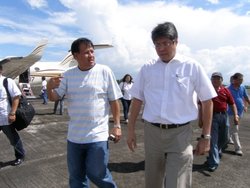
Manila Bulletin | January 17, 2011
By MELODY M. AGUIBA
MANILA, Philippines — The government may take a strong policy of aggressively promoting foreign investments even as it is set to hold in February a long-term visioning to make agriculture a top investment priority until year 2025.
The Congressional Oversight Committee on Agriculture and Fisheries Modernization (COCAFM) and the Department of Agriculture (DA) are set to host on Feb. 10 and 11 a planning session called “Agriculture and Fisheries 2025: Shared Vision, Shared Journey.”
This aims to make the sector a vehicle toward economic growth.
“It’s a golden opportunity to discuss where we want to be in 15 years. We’ll be bringing 100 plus of key players in agriculture — 60 percent from the private sector, 30 from the government, and 10 percent from the academe,” said Sen. Francis N. Pangilinan in a press briefing.
Stressing that “no developed country has become a first world country without developing its agriculture sector,” Pangilinan said the government should try “new approaches” in order to solve the country’s food security problems.
While the previous administration’s attempt to aggressively promote Chinese investments has met stiff opposition, He said there must be a way to raise cropping frequency, raise farmers’ income, and develop eight million hectares of the country’s idle forest lands.
“I’m willing to employ new approaches. I don’t think you can effect change unless you’re willing to try take risks and try new things. I think foreign investment projects have to be a win-win. We can’t operate on the basis of fear and speculation that foreign investment is bad.”
Malaysia has only four million hectares of forest lands, but it has developed these into a revenue source generating around P650 billion yearly through planting of rubber and palm oil, according to Pangilinan.
“(Department of Environment and Natural Resources) Sec. (Ramon) Paje tells me we have eight million hectares of forest land that are denuded, sitting idle. If the land is there, and they want to lease it for whatever — rubber, palm oil, grazing land — we’re gonna have to negotiate every investment that comes along,” he said.
COCAFM has 10 items on the list of priority for agriculture which will be discussed during the planning session.
These, according to Pangilinan, include raising investments in agriculture, raising farmers’ income, organizing farmers, building capacity of farmers through training, giving farmers access to credit, and providing them access to market and market information.
“It should be market-driven because now we have production-ouput approach,” he said.
A new policy in infrastructure investment in agriculture and farm-to-market roads (FMR) is to readily make available the entire budget that an irrigation facility or roads needs in order to deliver the desired output, the water or road, over the targeted period.











